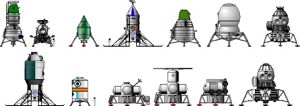
Home - Search - Browse - Alphabetic Index: 0- 1- 2- 3- 4- 5- 6- 7- 8- 9
A- B- C- D- E- F- G- H- I- J- K- L- M- N- O- P- Q- R- S- T- U- V- W- X- Y- Z
L3M-1972

L3M - Cutaway View
Cutaway views of early and later L3M manned lunar lander designs.
Status: Study 1972. Gross mass: 25,000 kg (55,000 lb). Height: 9.30 m (30.50 ft). Span: 9.40 m (30.80 ft).
This L3M would have allowed stays of up to 90 days by a crew of three.
In July 1970 Kuznetsov was given authorization to design substantially improved versions of the N1 rocket engines. The N1 that would utilize these engines was designated the N1F and would have a payload to a 225 km orbit of 105,000 kg.
Full go-ahead to develop a liquid hydrogen/liquid oxygen high energy upper stage for the N1F finally came in June 1970. The decision was made to develop a multi-engine Block Sr with a propellant mass of 66.4 metric tons. This single stage would be used in place of the previously-planned Blocks S and R to insert spacecraft of what was now termed the Lunar Expeditionary Complex (LEK) into low lunar orbit. It was also to be used to insert heavy spacecraft into geosynchronous orbit and on interplanetary trajectories.
The revised L3M for use with the Block Sr completed design in 1972. In this version the Soyuz capsule was completely enclosed in a pressurized 'hangar' (the OB, cocooned habitation block) which provided the crew with accommodation space. In this variant the crew could simply step out of the capsule into the hangar area without having to don space suits and conduct an EVA. This L3M would have had a mass of about 23 metric tons landed on the surface and have allowed stays of up to 90 days by a crew of three. The two-launch scenario would still be followed, with a single Block Sr from each N1 launch taking over duties of both the Blocks S and R in the previous plan. The DU engine block would perform the same ascent stage duties as the Block E of the original LK.
Crew Size: 2.
Family: Lunar Landers, Moon. Country: Russia. Spacecraft: L3M. Launch Vehicles: N1, N1F, N1 1969, N1F-L3M. Agency: Korolev bureau. Bibliography: 288, 367, 474.
 | LK with L3M mockup LK with L3M-1972 mock-up at Energia Credit: NASM |
 | L3M External views of early and later L3M manned lunar lander designs. |
1972 February 16 - . LV Family: N1. Launch Vehicle: N1F.
- N1-L3M moon landing draft project work authorised. - . Nation: Russia. Spacecraft Bus: L3M. Spacecraft: L3M-1972. Military-Industrial Commission (VPK) Decree 'On approval of work on the draft project for the N1-L3M two-launch lunar landing proposal' was issued..
1972 May 15 - . LV Family: N1. Launch Vehicle: N1F.
- N1-L3M development authorised. - . Nation: Russia. Spacecraft Bus: L3M. Spacecraft: L3M-1972. Council of Chief Designers Decree 'On approval of the N1-L3M proposal' was issued..
1973 January 1 - . LV Family: N1. Launch Vehicle: N1F-L3M.
- N1-L3M - . Nation: Russia. Program: Lunar L3. Spacecraft Bus: L3M. Spacecraft: L3M-1972. The first lunar expedition project, the N1-L3M, was studied in 1973..
1974 May 1 - . Launch Vehicle: N1.
- N1 cancellation imminent - .
Nation: Russia.
Related Persons: Keldysh,
Mishin,
Ustinov.
Program: Lunar L3.
Spacecraft: L3M-1972,
LK,
Mars 5NM,
MKBS,
Soyuz 7K-LOK.
Ustinov achieved a leadership consensus to kill the N1 by the beginning of May 1974. He achieved the agreement of the other Ministers on the Military-Industrial Commission, and finally Keldysh. Projects that were ongoing that were linked with the N1 included: the lunar base, MKBS space station, Mars robotic soil return spacecraft and manned expedition, a space radio telescope with a 100 m antenna, and multiple channel communications satellites. All of these died with the cancellation. If 8L had been successful, then after 1 or 2 further test launches, the N1-L3M could begin flying. That meant that the Soviet Union was within 3 to 4 years of establishing long-term lunar expeditions and a moon base. The Americans would have been leapfrogged. Instead, the leadership decided to develop a completely new heavy-lift launch vehicle, which never became operational before the Soviet Union collapsed.
1974 May 19 - . Launch Vehicle: N1.
- N1 launches suspended. - . Nation: Russia. Spacecraft Bus: L3M. Spacecraft: L3M-1972. Ministry of Defence Decree 'On suspension of further launches of the N1' was issued..
1974 June 24 - . Launch Vehicle: N1.
- N1-L3 work suspended. - . Nation: Russia. Spacecraft: L3M-1972, LK, Soyuz 7K-OK. TsKBEM Decree 'On suspension of work on the N1 -L3' was issued..
Back to top of page
Home - Search - Browse - Alphabetic Index: 0- 1- 2- 3- 4- 5- 6- 7- 8- 9
A- B- C- D- E- F- G- H- I- J- K- L- M- N- O- P- Q- R- S- T- U- V- W- X- Y- Z
© 1997-2019 Mark Wade - Contact
© / Conditions for Use
